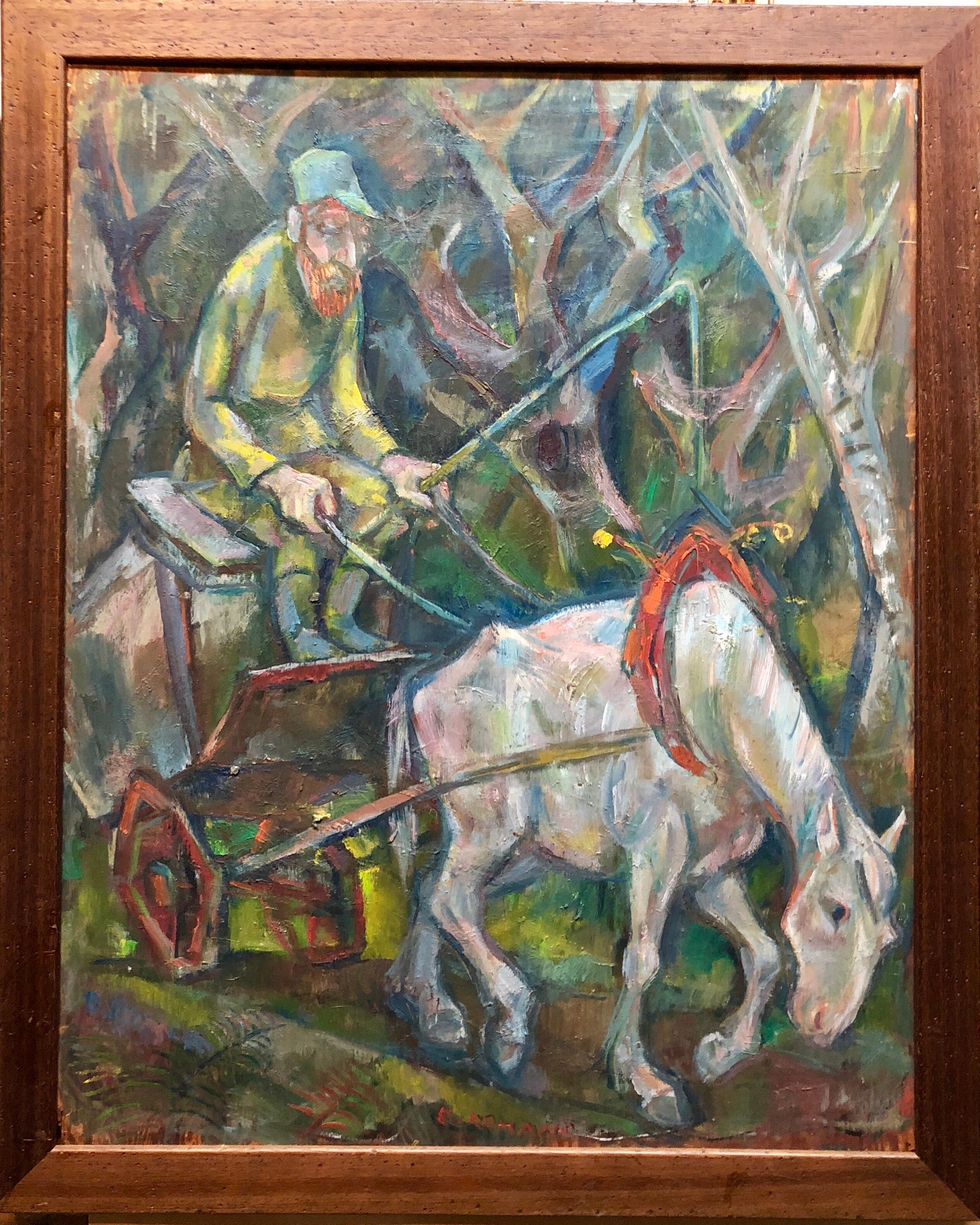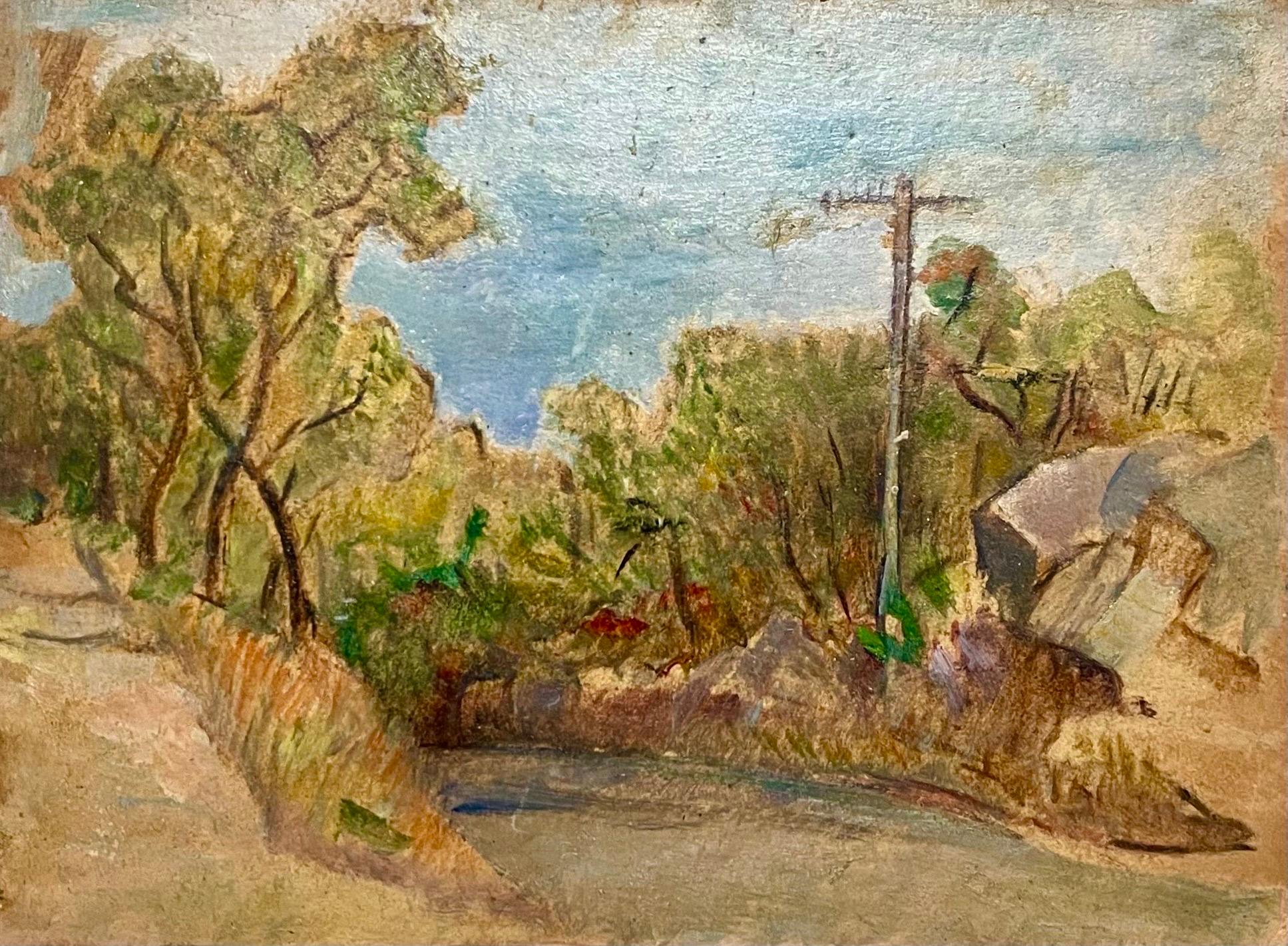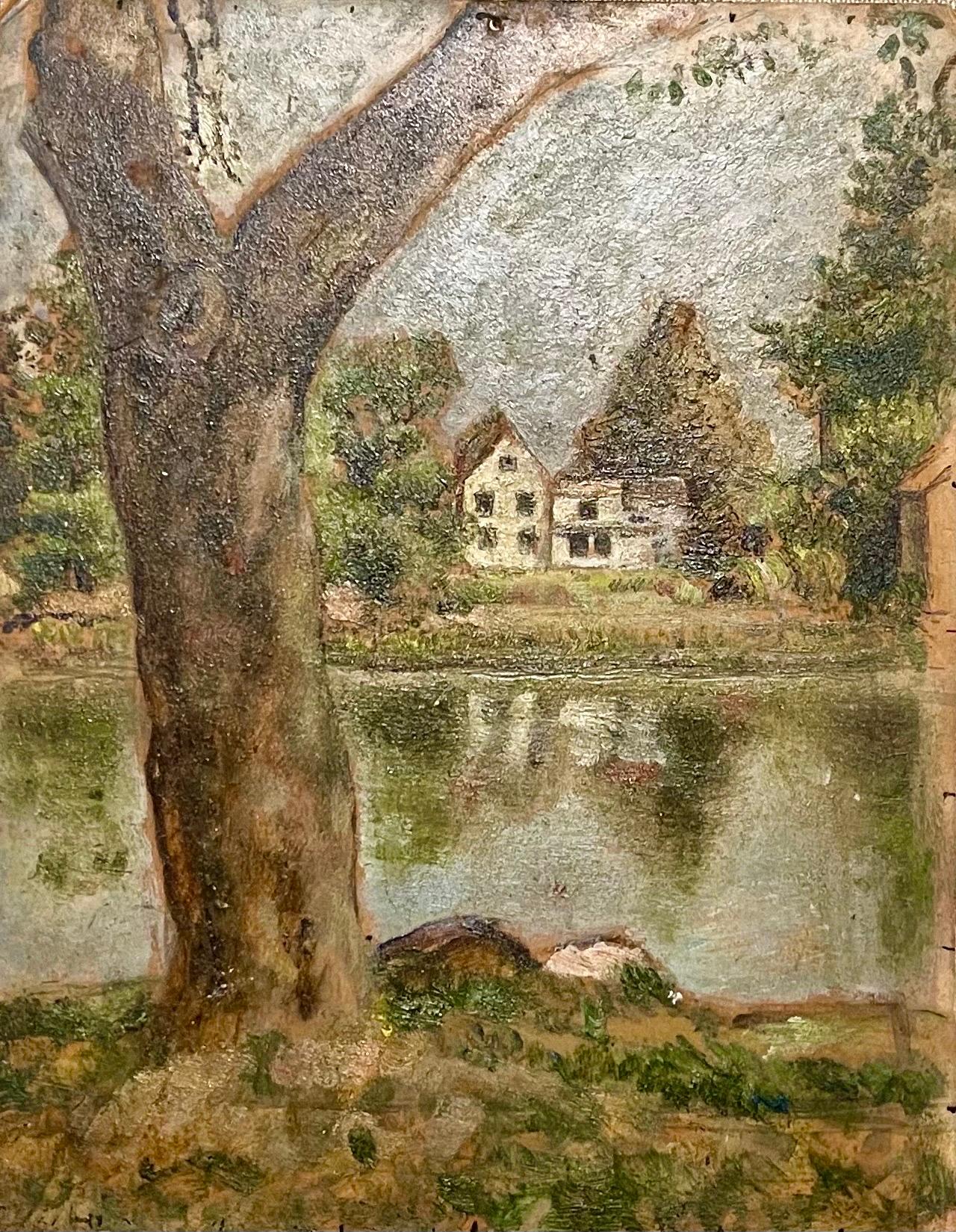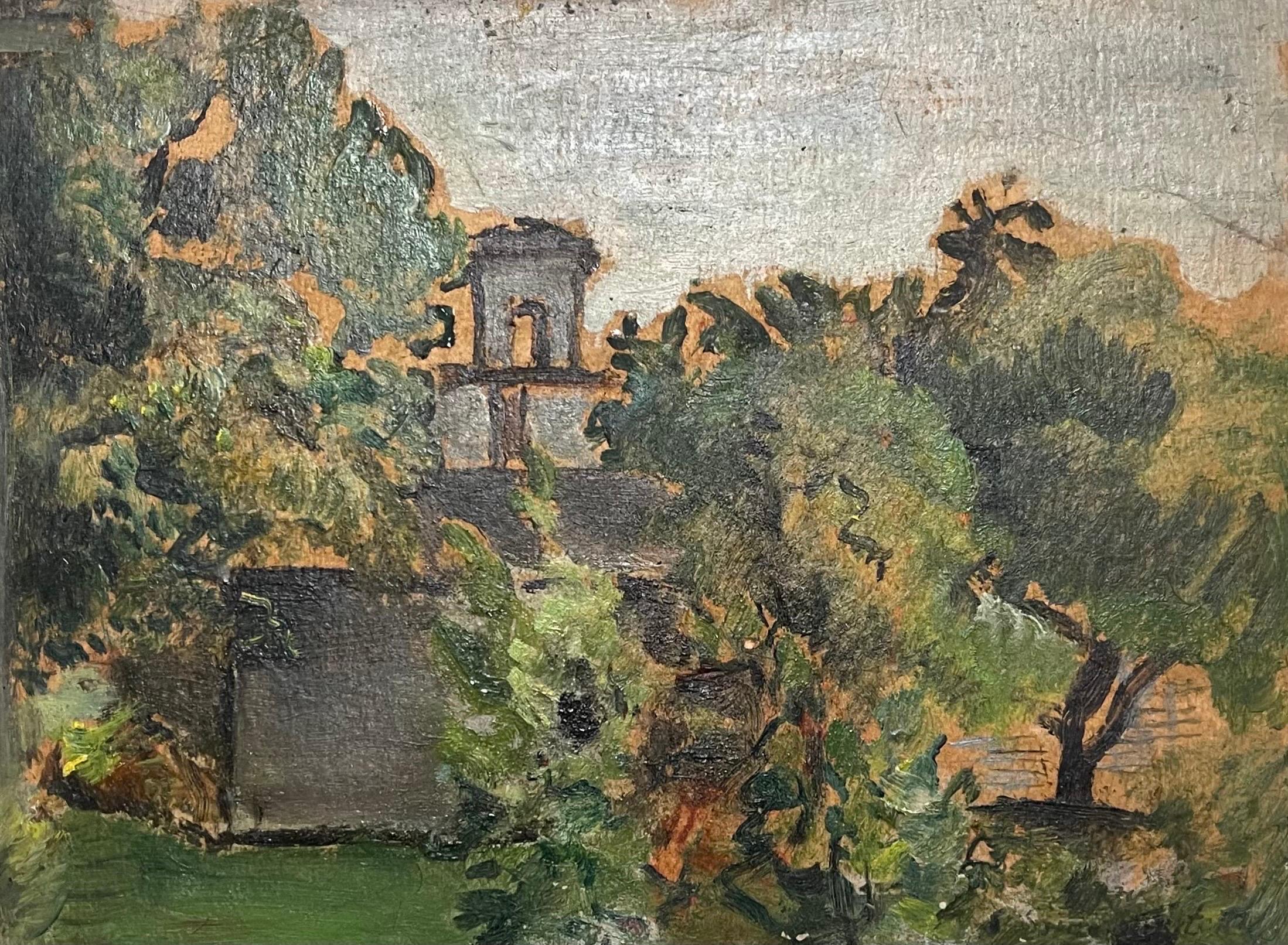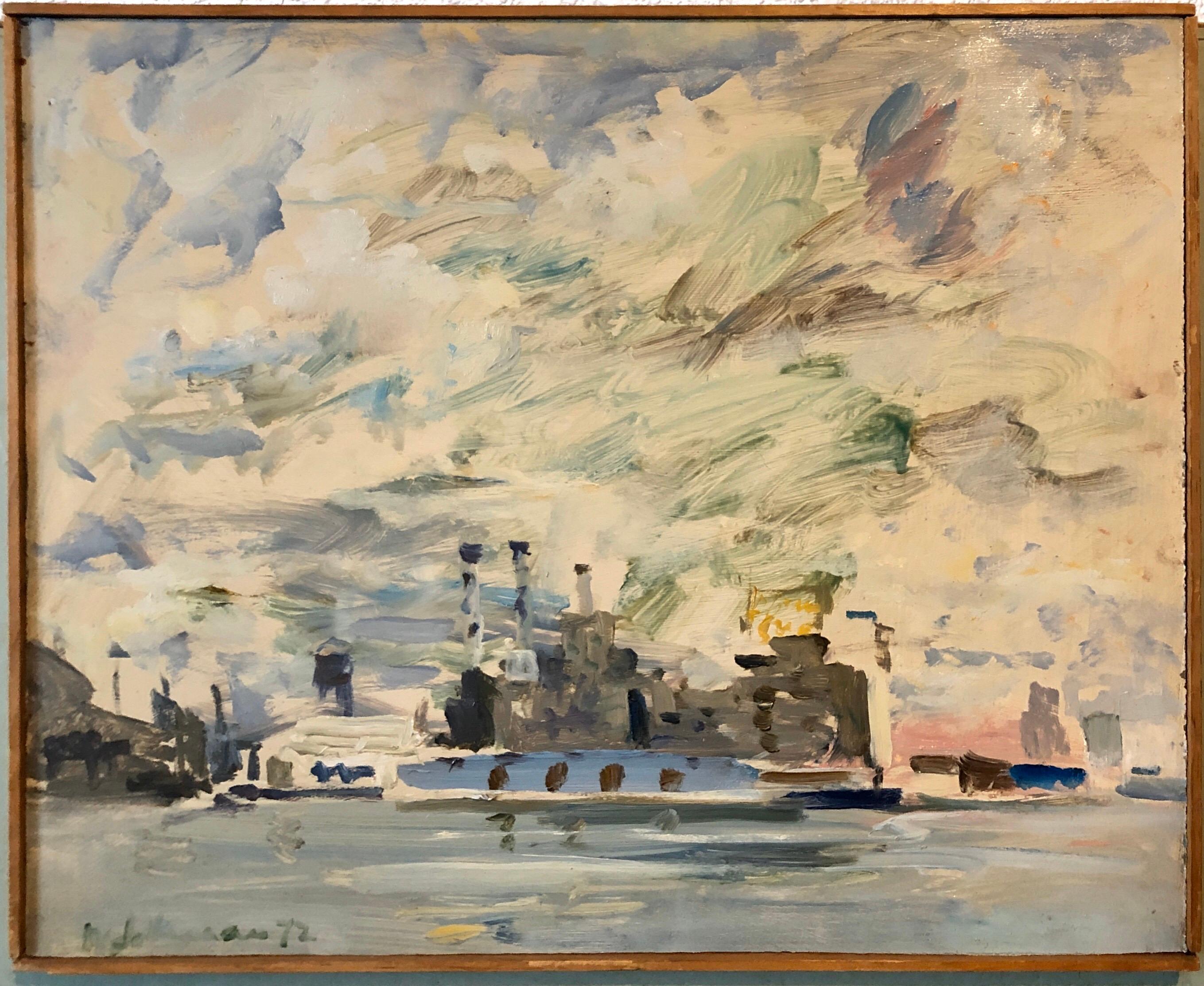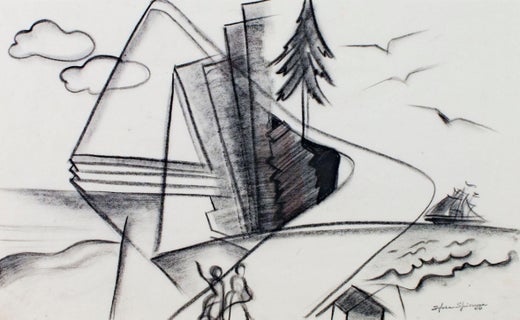Items Similar to 'Farmer with Cows' original Regionalist painting on board Midwestern landscape
Want more images or videos?
Request additional images or videos from the seller
1 of 14
Sylvia Spicuzza'Farmer with Cows' original Regionalist painting on board Midwestern landscapeca. 1938
ca. 1938
About the Item
This early work by American artist Sylvia Spicuzza is an excellent example of Regionalism: in the foreground, a farmer in blue stands before a herd of cattle. Beyond the fence of their corral, rows of haystacks draw the viewer's eye toward the farmhouse and the lush landscape under a blue sky. The reverse of the painting contains another original composition, with horses grazing before a red barn. The Regionalists, the most famous of which being Thomas Hart Benton, Grant Wood and John Steuart Curry, were so named because they were associated with particular regions of the United States – especially the Midwest. Even more, the movement was known for images like this, emphasizing the prosperity of America's heartland and agriculture.
23.75 x 15.5 inches, artwork
31.63 x 23.13 inches, frame
Stamped with artist's signature, lower right
Framed to conservation standards using archival materials including 100 percent rag mounting materials. Housed in a gold finish wood moulding with a linen-wrapped liner.
Overall good condition; some surface marks, top center; scattered pitting throughout bottom quarter; housed in a new custom frame.
Born in 1908, Sylvia Spicuzza was the daughter of noted painter Francesco Spicuzza. Sylvia's work is rich, diverse and fascinating collection of drawings, watercolors and prints from the 1920's to the 1990's. Her style ranges from early figurative drawings to Regionalism, Art Deco, lyrical abstractions of every conceivable subject (both real and imagined), as well as figurative paintings that reflect the work of Picasso, Kandinsky and Max Ernst in the 1930s and 1940s. Biomorphic and organic, her Modernist images are presented with Sylvia Spicuzza's own unique sense of style, humor, and fantasy.
- Creator:Sylvia Spicuzza (American)
- Creation Year:ca. 1938
- Dimensions:Height: 31.63 in (80.35 cm)Width: 23.13 in (58.76 cm)
- Medium:
- Movement & Style:
- Period:
- Condition:Overall good condition; some surface marks, top center; scattered pitting throughout bottom quarter; housed in a new custom frame.
- Gallery Location:Milwaukee, WI
- Reference Number:
Sylvia Spicuzza
Born in 1908, Sylvia Spicuzza was the daughter of noted painter Francesco Spicuzza. Sylvia devoted herself to teaching art to the students of Lake Bluff Elementary School in Shorewood, WI. During this time Sylvia produced a magnificent body of work that was undiscovered until her death. Sylvia's work is rich, diverse and fascinating collection of drawings, watercolors and prints from the 1920's to the 1990's. Her style ranges from early figurative drawings to regionalism, art deco, lyrical abstractions of every conceivable subject (both real and imagined), as well as figurative paintings that reflect the work of Picasso and Ernest Max in the 1930's and 1940's. Biomorphic and organic, Modernist images are presented with Sylvia Spicuzza's own unique sense of style, humor and fantasy. Exhibitions David Barnett Gallery, Milwaukee, Wisconsin Education Northwestern University, MFA, Illinois
About the Seller
4.9
Platinum Seller
These expertly vetted sellers are 1stDibs' most experienced sellers and are rated highest by our customers.
Established in 1966
1stDibs seller since 2017
391 sales on 1stDibs
Typical response time: 1 hour
- ShippingRetrieving quote...Ships From: Milwaukee, WI
- Return PolicyA return for this item may be initiated within 14 days of delivery.
More From This SellerView All
- "Stone Skipper, " Original Oil Painting of the LakeshoreBy Gregory SteeleLocated in Milwaukee, WI"Stone Skipper" is an original oil painting on board by Gregory D. Steele, signed in the lower left. This painted depicts a lakeshore beach in Door County, Wisconsin. The cold blue w...Category
Early 2000s Naturalistic Landscape Paintings
MaterialsOil, Board
- "Lake Michigan Beach Scene, " Oil on Canvas Seascape signed by Francesco SpicuzzaBy Francesco SpicuzzaLocated in Milwaukee, WI"Lake Michigan Beach Scene" is an original oil painting by Francesco Spicuzza. The artist painted this scene on canvas and then glued that canvas to a b...Category
1930s Figurative Paintings
MaterialsOil, Board, Canvas
- 'Two Musicians' original signed oil on mahogany painting, garden 19th centuryLocated in Milwaukee, WIÉmile Bemindt was a French artist active between 1859 and 1872 and is best known for work in the style of the Rococo Revival: During the late nineteenth ...Category
Late 19th Century Rococo Figurative Paintings
MaterialsBoard, Oil
- Southwest Indians at Shore and New Mexican Village, two-sided paintingLocated in Milwaukee, WIThe present artwork is an unusual example of the paintings of Fritzi Brod. It is painted on both sides: on one side, an image of three Native Americans on ...Category
1930s American Impressionist Figurative Paintings
MaterialsBoard, Oil
- "Couple on Bench at the Beach" Pastel on Paperboard signed by Francesco SpicuzzaBy Francesco SpicuzzaLocated in Milwaukee, WI"Couple on Bench at the Beach" is an original pastel drawing on paperboard by Francesco Spicuzza. The artist signed the piece in the lower left. This drawing depicts two figures sitting on a bench in front of a body of water. The artist used mostly pastel colors for this piece. 6 7/8" x 9 7/8" art 18 1/2" x 21 3/8" frame Francesco J. Spicuzza, born in Sicily on July 23, 1883, came to America at the age of 8. He supported himself as a fruit peddler until a newspaperman gave him $4 a week to go to school. He attended classes at the Milwaukee Art Students League, where he studied under Alexander Mueller. There he learned to paint in the then-fashionable "Munich School" technique, with detailed realism in heavy browns and grayed-out hues. Spicuzza completed eight grades in four years, and then in 1911, three businessmen advanced him enough money to allow him to study in New York under artist and teacher John Carlson. It was during this time that Spicuzza changed his style of painting, developing an impressionistic use of color, form and atmospheric renditions. After a period of grinding poverty, one of Spicuzza's pictures won a major New York competition. It was the first of 60 wins, both in the U.S. and Paris. He became a fashionable painter, and many of the leading collections have his work. Spicuzza's typical works were beach scenes, still life, landscapes and portraits done in pastels, oils, ink, charcoal and watercolors. Much of his work traced the history of Milwaukee in the early 1900s. He was probably best known for his scenes of women and children splashing in the waves...Category
1910s Impressionist Figurative Paintings
MaterialsPastel, Board, Paper
- "Two Country Village Women Outside Their House, " Oil on Canvas E. HyppoliteBy E. HyppoliteLocated in Milwaukee, WI"Two Country Village Women Outside Their House" is an original oil painting on canvas signed and dated in the lower right corner. It depicts two Haitian women working around their house. There is a variety of lush plants surrounding the house. 24 3/4" x 36" art 26 1/2" x 38 1/4" frame Framed to conservation standards in a floating frame with an brushed antique gold...Category
Early 2000s Figurative Paintings
MaterialsCanvas, Oil
You May Also Like
- Large Modernist Oil Painting 1940s, Judaica Hasidic Shtetl Wagon Driver WPA EraBy Emanuel Glicenstein RomanoLocated in Surfside, FLGenre: Modern Subject: Landscape with figure of horse, driver and wagon Medium: Oil Surface: wood Board EMANUEL ROMANO Rome, Italy, b. 1897, d. 1984 Emanuel Glicen Romano was born in Rome, September 23, 1897. His father Henryk Glicenstein was a sculptor and was living in Rome with his wife Helena (born Hirszenberg) when Emanuel was born. His father obtained Italian citizenship and adopted the name Enrico. Emanuel was brought up in Italy, Switzerland, Germany, England and Poland. In 1926 Emanuel Glicenstein Romano and his father sailed for New York. They briefly visited Chicago. Romano's sister, Beatrice, and mother only joined them in New York years later. Romano changed his name on his arrival to America and some have erroneously speculated that this was to avoid antisemitic discrimination. In truth, as the son of a highly-regarded artist, Romano changed his name to ensure that any success or recognition he would later attain, would be the result of nothing other than his own merit as an artist, and not on account of his father's fame. In 1936 Romano was worked for the WPA Federal Art Project creating murals. ( there were many jewish artists active with in the WPA period. notably Chaim Gross, Ben Shahn, Isaac and Moses Soyer, Abraham Rattner and many others. During and immediately after World War II, Romano created a series of allegorical works depicting graphic holocaust images that were held closely by the family until after his passing. One of these works is now on permanent display in the Florida Holocaust Museum in St. Petersburg Florida. Emanuel's father died in 1942 in a car accident before they could realize their shared dream of visiting Israel. In 1944 Romano, having completed his degree at the Pennsylvania Academy of Fine Arts and the Art Institute of Chicago, began teaching at the City College of New York. Romano moved to Safed, Israel in 1953 and established an art museum in his father's memory, the Glicenstein Museum. COLLECTIONS Indianapolis Museum of Art Metropolitan Museum of Art Boston Fine Arts Museum Fogg Museum Musée Nacional de France Recently his work has been added to the Florida Holocaust Museum collection. His notable works include his holocaust themed allegorical paintings as well as portraits of Marianne Moore, his father and William Carlos Williams...Category
1930s American Modern Figurative Paintings
MaterialsOil, Board
- Simka Simkhovitch WPA Artist Oil Painting Gouache American Modernist PowerlineBy Simka SimkhovitchLocated in Surfside, FLSimka Simkhovitch (Russian/American 1893 - 1949) This came with a small grouping from the artist's family, some were hand signed some were not. These were studies for larger paintings. Simka Simkhovitch (Симха Файбусович Симхович) (aka Simka Faibusovich Simkhovich) (Novozybkov, Russia May 21, 1885 O.S./June 2, 1885 N.S.—Greenwich, Connecticut February 25, 1949) was a Ukrainian-Russian Jewish artist and immigrant to the United States. He painted theater scenery in his early career and then had several showings in galleries in New York City. Winning Works Progress Administration (WPA) commissions in the 1930s, he completed murals for the post offices in Jackson, Mississippi and Beaufort, North Carolina. His works are in the permanent collections of the Dallas Museum of Art, the National Museum of American Art and the Whitney Museum of American Art. Born outside Kyiv (Petrograd Ukraine) into a Jewish family who owned a small department store. During a severe case of measles when he was seven, Simcha Simchovitch sketched the views outside his window and decided to become an artist, over his father's objections. Beginning in 1905, he studied at the Grekov Odessa Art School and upon completion of his studies in 1911 received a recommendation to be admitted to the Imperial Academy of Arts. Though he enrolled to begin classes in architecture, painting, and sculpture at the Imperial Academy, he was dropped from the school roster in December because of the quota on the number of Jewish students and drafted into the army. Simchovitch served as a private in the 175th Infantry Regiment Baturyn [ru] until his demobilization in 1912. Re-enrolling in the Imperial Academy, he audited classes. Simka Simkhovitch exhibited paintings and sculptures in 1918 as part of an exhibition of Jewish artists and in 1919 placed 1st in the competition "The Great Russian Revolution" with a painting called "Russian Revolution" which was hung in the State Museum of Revolution. In 1922, Simkha Simkhovitch exhibited at the International Book Fair in Florence (Italian: Fiera Internazionale del Libro di Firenze). In 1924, Simkhovitch came to the United States to make illustrations for Soviet textbooks and decided to immigrate instead. Initially he supported himself by doing commercial art and a few portrait commissions. In 1927, he was hired to paint a screen for a scene in the play "The Command to Love" by Fritz Gottwald and Rudolph Lothar which was playing at the Longacre Theatre on Broadway. Art dealers began clamoring for the screen and Simkhovitch began a career as a screen painter for the theater. Catching the attention of the screenwriter, Ernest Pascal, he worked as an illustrator for Pascal, who then introduced him to gallery owner, Marie Sterner. Simkhovitch's works appeared at the Marie Sterner Gallery beginning with a 1927 exhibit and were repeated the following year. Simkhovitch had an exhibit in 1929 at Sterner's on circus paintings. In 1931, he held a showing of works at the Helen Hackett Gallery, in New York City and later that same year he was one of the featured artists of a special exhibit in San Francisco at the California Palace of the Legion of Honor in Lincoln Park. The exhibit was coordinated by Marie Sterner and included four watercolors, including one titled "Nudes". He is of the generation of Russian Soviet artists such as Isaac Pailes, Serge Charchoune, Marc Chagall, Chana Orloff, Isaac Ilyich Levitan, and Ossip Zadkine. In 1936, Simkhovitch was selected to complete the mural for the WPA Post office project in Jackson, Mississippi. The mural was hung in the post office and courthouse in 1938 depicted a plantation theme. Painted on the wall behind the judge’s bench, “Pursuits of Life in Mississippi”, a depiction of black workers engaged in manual labor amid scenes of white professionals and socialites, was eventually covered over in later years during renovations due to its stereotypical African American imagery. Simka painted what he thought was typical of Jackson. His impression of pre-civil rights Mississippi was evidently Greek Revival column houses, weeping willow trees, working class families, and the oppression of African Americans. He painted African American men picking cotton, while a white man took account of the harvest and a white judge advised a white family, calling it Pursuits of Life in Mississippi. Though clearly endorsed by the government and initially generally well-received, the mural soon raised concerns with locals as the climate toward racial segregation began to change. The main concern was whether depictions that show African Americans in subjugated societal roles should be featured in a courtroom. The following year, his painting "Holiday" won praise at an exhibition in Lincoln, Nebraska. In 1940, Simkhovitch's second WPA post office project was completed when four murals, "The Cape Lookout Lighthouse and the Orville W. Mail Boat", "The Wreck of the Crissie Wright", "Sand Ponies" and "Canada Geese" were installed in Beaufort, North Carolina. The works were commissioned in 1938 and did not generate the controversy that the Jackson mural had. The main mural is "The Wreck of the Crissie Wright" and depicts a shipwreck which had occurred in Beaufort in 1866. "The Cape Lookout Lighthouse and the Orville W. Mail Boat" depicted the lighthouse built in 1859 and the mail boat that was running mail during the time which Simkhovitch was there. The boat ran mail for the area until 1957. "Sand Ponies" shows the wild horses common to the North Carolina barrier islands and "Canada Geese" showed the importance of hunting and fishing in the area. All four murals were restored in the 1990s by Elisabeth Speight, daughter of two other WPA muralists, Francis Speight...Category
1930s American Modern Landscape Paintings
MaterialsGouache, Oil, Board
- Simka Simkhovitch WPA Artist Oil Painting American Modernist Landscape Pond TreeBy Simka SimkhovitchLocated in Surfside, FLSimka Simkhovitch (Russian/American 1893 - 1949) This came with a small grouping from the artist's family, some were hand signed some were not. Thes...Category
1930s American Modern Landscape Paintings
MaterialsOil, Board
- Simka Simkhovitch WPA Artist Oil Painting American Modernist Landscape w TowerBy Simka SimkhovitchLocated in Surfside, FLSimka Simkhovitch (Russian/American 1893 - 1949) This came with a small grouping from the artist's family, some were hand signed some were not. Thes...Category
1930s American Modern Landscape Paintings
MaterialsOil, Board
- 1972 Gestural Oil Painting Boat in Harbor Figural Abstraction Raoul MiddlemanBy Raoul MiddlemanLocated in Surfside, FLRaoul Middleman (born 1935 in Baltimore, Maryland) is an American painter. Middleman has been a member of the Maryland Institute College of Art faculty since 1961. American University Museum at the Katzen Center has described Middleman as a "Baltimore maestro [whose] nudes are not pretty—they are sagging, dimpled, and real. His cityscapes reveal the underbelly of post-industrial rot, his narrative paintings give contemporary life to his personal obsessions. They are intelligent, messy, and utterly masterful." From an interview with RM "I was doing abstract art. Then Roy Lichtenstein came around, and I wanted to be current. I remember Grace Hartigan said, “You’ve gotta go to New York, seize destiny by the hand.” My friend Jon Schueler took my slides up to Eleanor Ward, who had the Stable Gallery. My Pop art paintings were discovered. I moved to New York into Malcolm Morley’s old loft down on South Street. Agnes Martin was upstairs... People who interest me come from different quarters. I knew guys around Schueler, like B.H. Friedman. But I also knew the Pop world pretty well – Al Hansen, Richard Artschwager, Lichtenstein. I became friends with Raoul Hague and I rented a place in Port Jervis, New York. I started doing my first landscapes up there. I thought making landscapes was the dumbest thing you could do. You got flies, insects, cow pies, humidity. But I loved it... I went down to the meetings of the Figurative Alliance. I met my friends there — Paul Resika, Paul Georges, Rosemarie Beck...Category
1970s American Modern Landscape Paintings
MaterialsOil, Board
- Bathers at the Quarry 1940s American Modernist Oil Painting WPA eraBy Theresa Berney LoewLocated in Surfside, FLSwimmers and sun tanners at the local watering hole. Her birth name was Theresa Berney. At the time of her passing she was known as Theresa Loew. Birth place: Baltimore artist, blo...Category
1940s American Modern Landscape Paintings
MaterialsOil, Board
Recently Viewed
View AllMore Ways To Browse
Gold Paint On Board
Original Art Deco Paintings
Art Deco Board
Agricultural Painting
Linen Wrapped
1940s Painting House
American Art Deco Painting
Cow Oil Painting
Oil Painting Cows
Cow Wood
1920 Oil On Board
Farmer Vintage
Farmers Vintage
Oil Paintings Of Cows
Farmer Oil Paintings
Art Deco Wood Painting
Kandinsky Oil Painting
Oil On Board Paintings 1940s
